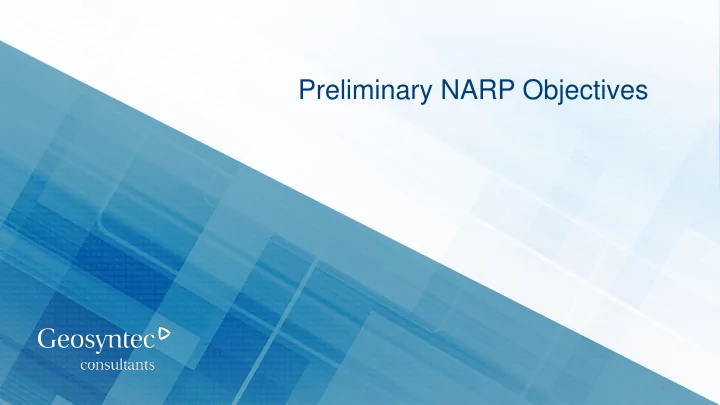

Preliminary NARP Objectives 1 GEOSYNTEC CONSULTANTS
DRWW Preliminary NARP Workplan Development Task 1: Project Management and Preliminary NARP Objectives Project Management: monthly progress reports, interim progress calls Develop Review Data Monitoring & Meet Review of Kick-off NARP Assessment Modeling with Finalize Draft Meeting Objectives & with Illinois Review Illinois Workplan Workplan Outline EPA Meeting EPA Task 2: Review Background Information Task 3: Identify Missing Components and Refine Objectives Data assessment: • Monitoring including nutrient and DO fluxes Evaluate • Previous modeling Refine Draft Watershed & Monitoring & • Watershed Based Plan: pollutant sources, NARP Outline of Hydraulic/Water Modeling modeling, and projects Objectives Workplan Quality Models, Options • IPS Tool Data Needs Complete needs assessment for DPR Data tributary flow and Assessment Task 4: Develop Preliminary Workplan pollutant loadings to Table/Maps mainstem EC Draft Scope, EC Draft Draft Complete needs Collabora Schedule, Collabor Workplan Workplan assessment for hydraulic tion Cost ation and water quality model of DPR and tributaries
When is a NARP Required? PHOSPHORUS RELATED IMPAIRMENT RISK OF EUTROPHICATION OTHER Listed on 303(d) list for: Information that plant, algal, or Permit can be re-opened if • Dissolved oxygen cyanobacterial growth is causing or • Phosphorus related impairment • Offensive condition (algae and/or will cause violations of water quality • Risk of eutrophication aquatic plant growth) standards • pH Dissolved oxygen • • Chlorophyll-a GEOSYNTEC CONSULTANTS
Impaired Reaches • Impaired Reaches Segment Miles Impairment Arsenic, Mercury, Oxygen, Dissolved, Sedimentation/Siltation, Total IL_G-25 6.9 Suspended Solids (TSS) Cause Unknown, Mercury, Phosphorus (Total), Polychlorinated IL_G-35 5.0 biphenyls IL_G-36 7.2 Fecal Coliform, Mercury, Phosphorus (Total), Polychlorinated biphenyls Arsenic, Chloride, Fecal Coliform, Mercury, Phosphorus (Total), IL_G-07 10.8 Polychlorinated biphenyls Fecal Coliform, Mercury, Oxygen, Dissolved, Total Suspended Solids IL_G-08 1.0 (TSS) IL_G-26 6.0 Cause Unknown, Mercury, Polychlorinated biphenyls IL_GWA 5.5 Arsenic, Manganese, Phosphorus (Total), Sedimentation/Siltation IL_GST 10.7 Total Suspended Solids (TSS) IL_GW-02 13.0 Oxygen, Dissolved, pH IL_GU-02 11.3 Oxygen, Dissolved IL_GWAA 4.0 Arsenic, Phosphorus (Total), Sedimentation/Siltation NARP related impairment 4 GEOSYNTEC CONSULTANTS Based on IEPA data only*
Risk of Eutrophication • Site is at risk of eutrophication if one of following criteria is satisfied – pH > 9 – Median Chl-a > 25 ug/L – pH > 8.35 & DOsat > 110% for 2+ days • IEPA data – Three sites found at risk of eutrophication • DRWW data – No station found at risk of eutrophication – Limited continuous data available* for assessment *Only 2017 data 5 GEOSYNTEC CONSULTANTS
NARP Process Establish time line Point and/or Nonpoint Source of required Determine phosphorus input phosphorus input reductions Nutrient Science Advisory Committee reductions to or site-specific watershed targets address Establish water impairments quality targets Develop NARP Objectives Join/Establish a Watershed Graphic based on Illinois Protection Agency NPDES Permitting Language Group 6 GEOSYNTEC CONSULTANTS
Possible NARP Outcomes No impairment related to P Point source reductions in P not needed NARP Point source reductions in P needed Both point and nonpoint source reductions in P needed Other measures needed 7 GEOSYNTEC CONSULTANTS
NARP Building Blocks Data Integrated NARP Priority Modeling System Stakeholder Illinois EPA guidance recommends Input that NARP should be based on data and sound scientific rationale 8 GEOSYNTEC CONSULTANTS
NARP Building Blocks Data • Define contribution of upstream sources • Calibrate the IPS and watershed, hydrodynamic, and water quality models Measure improvements resulting from management actions • Modeling Integrated Priority System (IPS) 1) Fill in spatial and temporal gaps in 1) Prioritize Capital Improvement Data the data Projects to improve water quality and 2) Calculate contribution of point and aquatic habitat for different geographic nonpoint sources P-loads scales: Integrated • Watershed NARP 3) Forecast potential improvements in Modeling Priority • Subwatershed water quality from reductions in System • Municipal point and nonpoint source P-loads 2) Establish thresholds for various 4) Forecast potential improvements stressors (including P) for biological from other management actions Stakeholder Input scores (e.g., source reduction, riparian Stakeholder Input shading, streambank stabilization, • Inform development of the NARP lake management) • Define potential management actions and constraints 9 GEOSYNTEC CONSULTANTS
Potential DRWW NARP Objectives 1) Establish watershed-specific water quality targets 2) Determine phosphorus reductions needed to achieve site-specific water quality targets or if targets are infeasible 3) Assess the other measures needed to address aquatic life impairments 4) Identify specific projects to address water quality and aquatic life impairments and establish timeline for implementation 5) Identify mechanisms to facilitate cost-effective implementation of the NARP 10 GEOSYNTEC CONSULTANTS
Potential DRWW NARP Objective 1 Establish watershed-specific targets for water quality • Dissolved oxygen • Chlorophyll-a • Total phosphorus (dissolved reactive phosphorus) • Nitrogen? Wadeable Streams Non Wadeable Streams *Some streams might require both sestonic and benthic chlorophyll Sestonic chlorophyll-a* Benthic chlorophyll-a 11 GEOSYNTEC CONSULTANTS
Potential DRWW NARP Objective 2 Determine phosphorus reductions needed to achieve site-specific water quality targets or if targets are infeasible • Point sources – Wastewater treatment plants • 8 major • 10 minor • Nonpoint sources – Small Municipal Separate Storm Sewer Systems (MS4s) – Agriculture 12 GEOSYNTEC CONSULTANTS Des Plaines River WBP
Potential DRWW NARP Objective 3 Assess the other measures needed to address aquatic life impairments MBI/2017-8-7 MBI/2018-10-10 13 GEOSYNTEC CONSULTANTS
Potential DRWW NARP Objective 4 Identify specific projects to address water quality and aquatic life impairments and establish timeline for implementation Example output from Geosyntec’s BMP prioritization tool for Mill Creek showing the high priority parcels for BMP application overlaid with catchment loading. 14 GEOSYNTEC CONSULTANTS
Potential DRWW NARP Objective 5 Identify mechanisms to facilitate cost-effective implementation of the NARP: • Point-to-point trading program • Point-to-nonpoint trading program • Funding plan 15 GEOSYNTEC CONSULTANTS
Recommend
More recommend